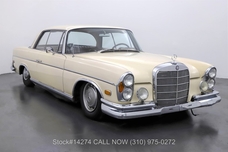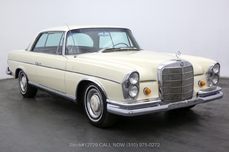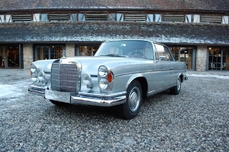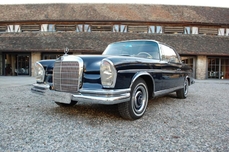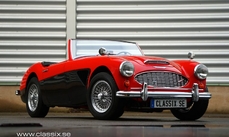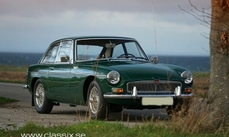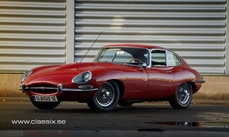Mercedes-Benz 300SE Coupé w112 W112 Coupe 1963
General description :
Mercedes 300SE W112 Coupe 1963 for sale
The description of this car should be seen from the perspective that it is an unrestored and original car from 1963
Exterior: The paint is nice even parts of it is believed to be the original. Also chrome parts are in very good condition. Windows have never been removed from this car, but rubber is still very good just like all glass. The W112 300SE is to me the best-looking coupe from Mercedes since it sits very low and have that chromed side trim making it look even longer and sleeker. Please note that this is 99% unwelded car! One very small patch was found in the floor otherwise all original.
Interior: Here we have an all original interior that is still in amazing condition. Yes, there is some cracks in the lacquer on the wood panels, and yes, the carpet is a little bit faded from the sun. But the leather is absolutely beautiful, just like all chrome and the instruments. You can truly feel the year 1963 when you sit inside and drive this car. I have had some of the best classic car experiences in a car like this, coming trough the night over the mountains hearing that sweet six humming away km after km. Nice time period correct working radio.
Engine: I am pretty sure the odometer in this car has turned one once, so it has around 150.000km when I am writing this in total. The engine runs very nice and there is no smoke. The car had been standing for some time when I found it. It was parked in 1995 and I started working on it in 2019. All fluids and filters where replaced. The tank was cleaned out properly and new seals where fitted to the fuel pump. A new exhaust pipe where fitted and new rubber doughnuts in the air suspension all around. New water pump and many cooling hoses and clamps are new. The brake system was a big job and all callipers have been rebuilt, new hoses, main cylinder and brake servo. Also clutch cylinder where rebuilt.
History: I am still working on tracking down the history of this car, but it looks like there have been 3 owners over the years. And I have a data card for the car showing that it is in correct colour and with correct engine. The car comes with a binder with all collected receipts for the parts and work mentioned above. A major investment has been made in 2019 to put this car back to its former glory. Comes with original items such as handbook in original plastic pouch, spare, jack and original tools.
But before you enquire, check with your wife/girlfriend, check your bank account and measure your garage please.
http://www.classix.se/cars-for-sale/item/556-mercedes-300se-w112-coupe-1963
1963 Mercedes-Benz 300SE Coupé w112 W112 Coupe is listed sold on ClassicDigest in Saxtorp by Auto Dealer for €54000.
Car Facts
Car type : Car Make : Mercedes-Benz Model : 300SE Coupé w112 Model Version : W112 Coupe Engine size : 0.0 Model Year : 1963 Sub type : Coupé Location : Saxtorp
Sold
Seller Information
Sold
People who viewed this Mercedes-Benz 300SE Coupé w112 also viewed similar Mercedes-Benz listed at ClassicDigest
Other cars listed for sale by this dealer
About Mercedes-Benz
In the annals of automotive history, the journey of Mercedes-Benz is a tale that unfolds with the ingenuity of its founding pioneers. In the year 1886, Karl Benz crafted the Benz Patent Motorwagen, a creation that would go down in history as the world's inaugural automobile. Unbeknownst to him, this moment marked the genesis of what would evolve into the most illustrious premium car manufacturer globally. The financial underpinning of this pioneering venture, interestingly, was provided by Karl Benz's wife, Bertha Benz, demonstrating a remarkable partnership that would set the tone for Mercedes-Benz's legacy.A parallel narrative emerged not far away, as Daimler-Motoren-Gesellschaft, founded by Gottlieb Daimler and Wilhelm Maybach, entered the scene. In 1901, they unveiled their automobile under the now-famous moniker "Mercedes," meaning "godsend" in Spanish. This name was bestowed upon the car at the behest of Emil Jellinek's daughter, the distributor for Daimler-Motoren-Gesellschaft. The wheels of innovation were set in motion.
Fast forward to 1926, a pivotal year that witnessed the merger of Daimler with Benz & Cie., culminating in the birth of Daimler-Benz. The amalgamation saw the adoption of "Mercedes-Benz" as the distinguished trademark for their automobiles, fusing the legacies of two visionary entities into one.
Contrary to perceptions of conservatism, the trajectory of Daimler-Benz unfolds as a chronicle of industry firsts. From the introduction of the honeycomb radiator to the float carburetor, and the pioneering implementation of four-wheel brakes in 1924, Daimler-Benz consistently pushed the boundaries of automotive innovation. The diesel-powered Mercedes-Benz 260 D in 1936 marked the inception of diesel engines in passenger cars. The iconic Mercedes-Benz 300SL Gullwing made history as the first car with direct fuel injection, albeit the Gutbrod's tiny 2-stroke engine can claim precedence.
Safety innovations became a hallmark, with Béla Barényi's patented safety cell design in the "Ponton"-models in 1951, featuring front and rear crumple zones. The W116 450SEL 6.9 saw the introduction of the Anti-Lock Brake system (ABS), another pioneering safety feature. From the first production airbags and beyond, the legacy of "firsts" continued to be etched into the fabric of Daimler-Benz.
Over its centennial journey, Mercedes-Benz has not merely produced cars but has sculpted automotive icons. The SSKL, 710 SSK Trossi Roadster, 770K Grosser, 540K Spezial Roadster, 300SL Gullwing, w100 600 Pullman, w111 280SE 3.5 Flachkühler, w113 230SL Pagoda, w109 300 SEL 6.3, and w201 2.3-16 Cosworth stand testament to the brand's commitment to engineering excellence.
The roaring Silver Arrows, or "Silberpfeile," including the W 25, W 125, W154, W165, and W196, created a legacy of dominance on the racetrack. These machines were not merely cars; they were expressions of precision, speed, and an indomitable spirit that left their competitors in the dust.
As Mercedes-Benz marches into the future, it does so not just as an automaker but as a custodian of a legacy, a torchbearer of innovation, and a beacon of automotive excellence. The road ahead is sure to witness the continued fusion of cutting-edge technology, timeless design, and an unwavering commitment to setting new standards in the world of automobiles.
One luminary figure who left an indelible mark was Béla Barényi, often heralded as the "father of passive safety" for his pioneering work in safety engineering. His patented safety cell design, featuring front and rear crumple zones, became a hallmark of Mercedes-Benz's commitment to occupant safety, setting new standards that reverberated throughout the automotive world.
Moving through the chronicles, the collaborative genius of Wilhelm Maybach, alongside Gottlieb Daimler, laid the foundation for Daimler-Motoren-Gesellschaft. Their innovations not only birthed the first Mercedes but established a culture of relentless pursuit of technological excellence that remains integral to Mercedes-Benz's DNA.
In the post-merger era of 1926, Ferdinand Porsche emerged as a prominent figure within Mercedes-Benz. His work on the Mercedes-Benz S-Type, a supercharged race car, garnered acclaim and set the stage for a legacy that extended far beyond the marque. Porsche's impact would later extend to his eponymous company, but his influence at Mercedes-Benz during those formative years was pivotal.
As the 20th century progressed, the legendary Rudolf Uhlenhaut emerged as a key figure. Uhlenhaut, an accomplished engineer and the driving force behind the iconic Silver Arrows, played a crucial role in Mercedes-Benz's dominance in motorsports. His engineering prowess and attention to detail were instrumental in creating some of the most formidable racing cars of the era.
In the latter half of the century, figures like Bruno Sacco, the head of design at Mercedes-Benz from 1975 to 1999, left an indelible imprint on the brand's aesthetic identity. Sacco's design philosophy, characterized by clean lines and timeless elegance, shaped iconic models like the W126 S-Class and the W201 190E, solidifying Mercedes-Benz's reputation for luxury and sophistication.
The narrative would be incomplete without acknowledging the contributions of engineers like Hans Scherenberg, whose leadership in the 1970s ushered in a new era of technological innovation at Mercedes-Benz. Scherenberg's tenure saw the development of groundbreaking technologies, including the Anti-Lock Brake system (ABS) and the introduction of airbags in production cars.



